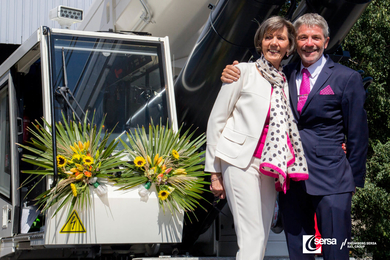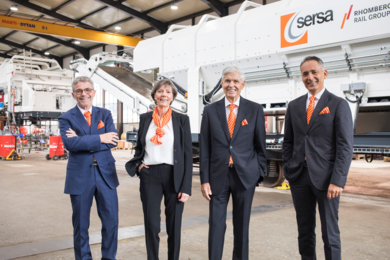10 Years of the Rhomberg Sersa Rail Group, as recounted by Markus Pfarl, Head of Mechanised Track Construction and Authorised Signatory for Bahnbau Wels, responsible for mechanised track construction and thereby the use and maintenance of track-building machinery as well as operative implementation of railway traffic in Austria and southern Germany; with the company since 1996.
Even before the merger in 2012, Bahnbau Wels had contact with Sersa. I remember the construction project regarding the safety retrofitting of the Arlberg Tunnel from 2005 to 2006 when we rented Sersa machines to overcome capacity bottlenecks. In 2012, the year of the joint venture, there was also the product returns business. Here, Bahnbau Wels in Switzerland could help out with the implementation of logistics vehicles during the construction project on the Simplon Tunnel. What changed after the merger was the stronger networking with Sersa’s colleagues. We interact on software rollout projects or in the machinery sector to cover peak periods. To assist in bridging Sersa’s peak workload, for example, we made a crane available in and around Zurich in 2019. We work with our Swiss colleagues on a partnership basis - the mutual lending of machines and employees really works well and I am happy about that. When you see Sersa vehicles in Austria and you see Bahnbau Wels vehicles in Switzerland, then it is proof that it does not only work in theory.
A group made up of agile functioning units
The big advantage of the merger: We are small, agile units that can fall back on the large Rhomberg Sersa Rail Group. We get support within the group and do not have to rely on suppliers. Even if our areas of operation are clearly defined, we know the respective contact persons and can react quickly. Our close proximity to the decision makers, the C-level and the Owner Board, helps to ensure that our small units operate quickly and flexibly. It is evident from the decisions made that we are a family enterprise. The owners are present and visible, even among the employees. Both owners, for example, are regularly present at Christmas parties or make a spontaneous visit to the workshop on St. Nicholas Day. That’s good for the employees. It shows appreciation when we get information directly and first-hand.
Offering new developments to the whole group
The wider benefits of the merger between the two companies are evident with regard to new developments. The development division of Sersa works together with the colleagues here in Wels in project groups and in workshops. We have lively exchanges about development and sales. For instance, new types of simulation systems for training in the railway sector were developed in Switzerland with the simulation provider NXRT. Together with Christian Schnyder, we also present these to our clients in Austria. The modern narrow-gauge measuring systems developed in Switzerland are likewise offered to clients in Austria.
At the forefront with new technologies
In 2032 we will have to have solved the challenges regarding the shortage of skilled personnel. This is a general problem in society; it does not only affect us. But in railway construction, in particular, employees are facing special challenges on the construction sites. Modern machinery, working time models that are as appealing as possible and varied activities are needed to attract people to this field.
By 2032, we are heavily involved in the application of new technologies. We are right at the forefront in the field of climate-friendly machines that are provided by green electricity from overhead lines. We started to become a pioneer in this field years before. Through new machine technologies in our group, our clients are able to receive additional measurement data for their track systems and to evaluate these. And this in a much better way than was previously possible. We support our clients to be fit for the future, also in 2032.







